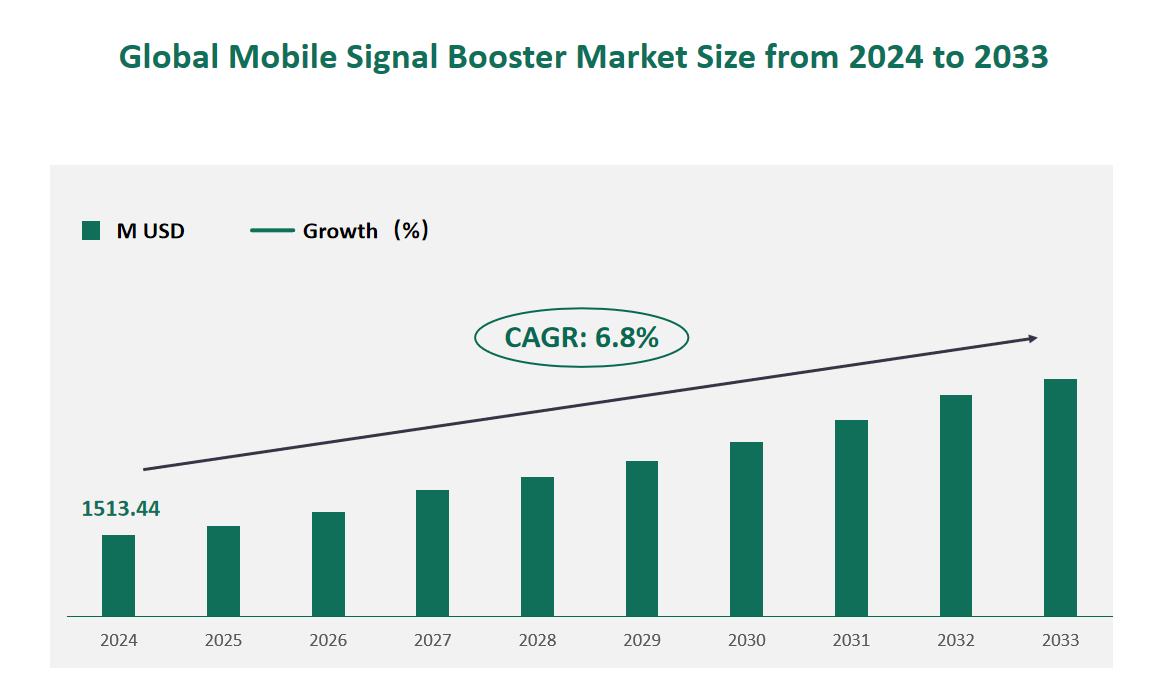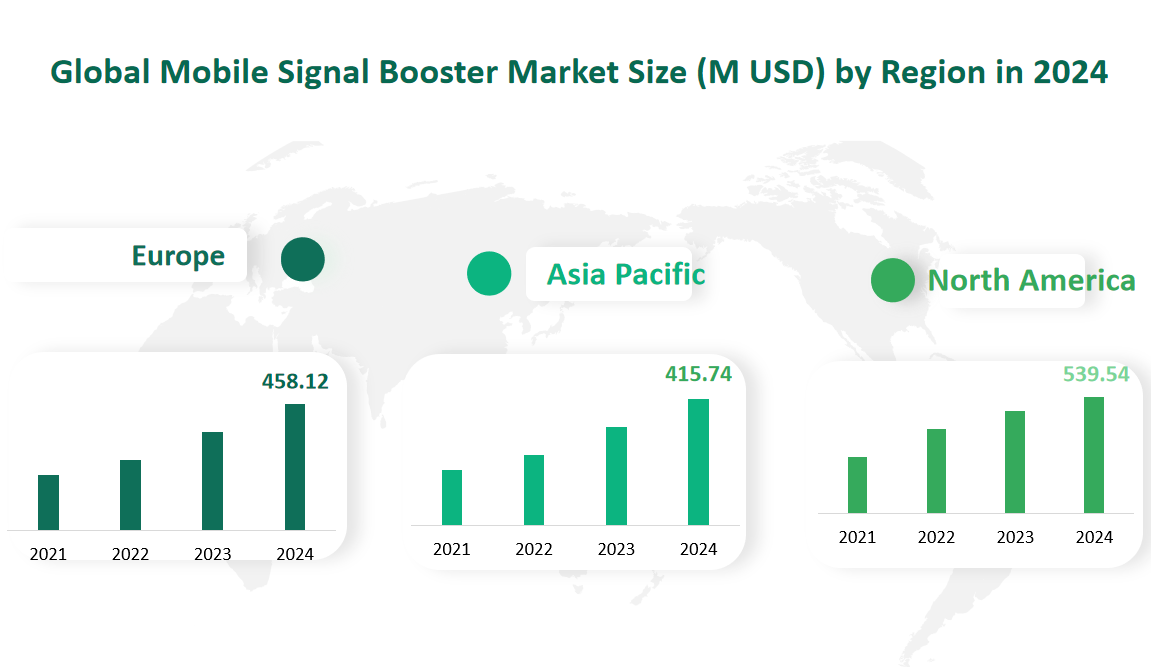1 Global Mobile Signal Booster Market Size (Value) and CAGR (2024-2033)
In 2024, the global Mobile Signal Booster market was valued at USD 1513.44 million, with a CAGR of 6.8% from 2024 to 2033.
Mobile Signal Booster is mainly used to receive signals from cellular base stations, filter, amplify, and then retransmit the signals to mobile devices. Mobile Signal Booster can extend the coverage of base stations, allowing higher gain and higher power operation.
Figure Global Mobile Signal Booster Market Size (M USD) and CAGR 2024-2033

2 Mobile Signal Booster Market Drivers
The proliferation of mobile devices has transformed the way people communicate, access information, and entertain themselves. According to Statista, in 2020, the number of independent mobile internet users reached 4.28 billion, accounting for over 90% of the global internet population. This widespread adoption of mobile devices has led to a growing need for stronger and more reliable cellular signals. In areas with weak or no signal, such as shopping malls, hotels, airports, subways, and rural regions, the demand for signal boosters is particularly high. Mobile Signal Boosters address these needs by extending coverage, improving communication quality, and preventing dropped calls, thereby enhancing the overall user experience.
The continuous expansion of public and private infrastructure, including universities, business parks, campuses, and large commercial centers, has created a significant demand for cost-effective solutions to enhance cellular coverage. Mobile Signal Boosters offer an affordable alternative to more expensive Distributed Antenna Systems (DAS), which require extensive installation and maintenance efforts. For instance, in museums, halls, and other indoor areas with low Average Revenue Per User (ARPU), operators often prefer signal boosters due to their cost-effectiveness. As the market for building infrastructure grows, the adoption rate of Mobile Signal Boosters is expected to increase, further driving market expansion.
The rise of e-commerce platforms such as Amazon has significantly impacted the Mobile Signal Booster market. Online retail channels have broadened the sales avenues for these products, making them more accessible to consumers. The convenience of online shopping and the ability to deliver products quickly have contributed to the increasing market share of e-commerce in total retail sales.
3 Mobile Signal Booster Market Restraints
One of the primary challenges facing the Mobile Signal Booster market is the strict regulatory environment. Signal boosters operate by amplifying RF signals, which can potentially interfere with public communication networks, such as base station transceivers. As a result, regulatory bodies like the Federal Communications Commission (FCC) and the International Telecommunication Union (ITU) impose strict guidelines on the development and sale of these devices.
The availability of Distributed Antenna Systems (DAS) presents a significant competitive challenge to the Mobile Signal Booster market. DAS solutions offer superior coverage and capacity, making them ideal for large-scale deployments in office buildings, hospitals, stadiums, and other high-density areas. These systems can provide high-speed, low-latency 5G coverage and support large numbers of mobile devices. As DAS technologies continue to evolve and become more cost-effective, they may limit the market share available to Mobile Signal Boosters.
Illegal imports, sales, and usage of Mobile Signal Boosters pose a significant threat to the market’s integrity. In some regions, such as India, the unauthorized use of signal boosters has led to disruptions in the telecommunications network, resulting in a decline in service quality. Regulatory bodies have responded by cracking down on illegal activities and imposing stricter controls on the sale and distribution of these devices. This not only hampers market growth but also creates uncertainty for legitimate businesses.
4 Global Mobile Signal Booster Market Size and Share by Type in 2024
Analog Signal Boosters are traditional devices that amplify the carrier frequency of cellular signals using analog technology. These boosters are widely used due to their simplicity and effectiveness in enhancing signal strength. They are typically sold with outdoor antenna cables and kits, requiring installation by the user. Analog Signal Boosters are particularly popular in areas with weak signal coverage, such as rural and suburban regions, where they can significantly improve communication quality. In 2024, Analog Signal Boosters accounted for a larger share of the market, reflecting their widespread use and reliability. The market size of Analog Signal Boosters in 2024 was 795.92 million USD, indicating their continued importance in providing basic signal enhancement solutions.
Digital Signal Boosters represent a more advanced technology compared to their analog counterparts. These devices are designed to enhance digital signals, which are increasingly important with the development of 4G and 5G networks. Digital Signal Boosters offer several advantages, including better signal quality, higher data transmission rates, and improved compatibility with modern cellular networks. They are particularly suited for urban areas and high-density environments where digital connectivity is crucial. The market size for Digital Signal Boosters in 2024 was 717.52 million USD, showing significant growth potential driven by the increasing demand for high-speed data and the expansion of digital communication networks.
Table Global Mobile Signal Booster Market Size and Share by Type in 2024
Type | Market Size (M USD) 2024 | Market Share 2024 |
Analog Signal Booster | 795.92 | 52.59% |
Digital Signal Booster | 717.52 | 47.41% |
5 Global Mobile Signal Booster Market Size and Share by Application in 2024
In 2024, the market size for Mobile Signal Boosters in Densely Populated Areas reached 867.96 million USD. The demand in these regions is driven by the need to enhance signal strength and coverage to support high data usage and prevent dropped calls. Signal boosters play a crucial role in ensuring seamless connectivity in areas with high user density and significant network strain.
Urban Fringe areas represent the transitional zones between urban centers and rural regions. These areas often experience weaker signal strength due to their distance from primary cellular towers. In 2024, the market size for Mobile Signal Boosters in Urban Fringe areas was 417.56 million USD. The demand here is driven by the need to bridge the gap between strong urban signals and weaker rural signals, ensuring continuous connectivity for residents and businesses located in these zones.
Suburban and Rural Areas are characterized by lower population density and greater distances between cellular towers. These regions often suffer from weak or inconsistent signal coverage. In 2024, the market size for Mobile Signal Boosters in Suburban and Rural Areas was 227.92 million USD. Signal boosters are particularly important in these areas, as they provide essential connectivity for residents, businesses, and emergency services. The demand is driven by the need to enhance signal strength and improve overall network reliability in areas with sparse infrastructure.
Table Global Mobile Signal Booster Market Size and Share by Application in 2024
Application | Market Size (M USD) 2024 | Market Share 2024 |
Densely Populated Areas | 867.96 | 57.35% |
Urban Fringe | 417.56 | 27.59% |
Suburban and Rural Areas | 227.92 | 15.06% |
6 Global Mobile Signal Booster Market Size by Region in 2024
North America has historically been a dominant market for Mobile Signal Boosters, driven by the high demand for reliable connectivity in both urban and rural areas. In 2024, the market size in North America was 539.54 million USD. The region’s advanced infrastructure and high consumer demand for seamless communication have contributed to its strong market position. Additionally, the rapid adoption of 5G technology in North America has further fueled the need for signal boosters to enhance network coverage and performance.
Europe also represents a significant market for Mobile Signal Boosters, with a market size of 458.12 million USD in 2024. European countries have diverse geographical landscapes, ranging from dense urban centers to remote rural areas, all of which require reliable signal enhancement solutions. The demand is driven by the need to support high data usage and ensure continuous connectivity across these varied environments. Furthermore, the regulatory focus on improving network quality and coverage has contributed to the growth of the signal booster market in Europe.
The Asia-Pacific region is emerging as a key market for Mobile Signal Boosters, with a market size of 415.74 million USD in 2024. This growth is driven by rapid urbanization, increasing mobile phone penetration, and the need for enhanced connectivity in both urban and rural areas. Countries like China, Japan, and South Korea are at the forefront of technological advancements, driving the demand for advanced signal booster solutions. Additionally, the region’s vast geographical area and diverse population density create a significant need for signal enhancement to ensure widespread connectivity.
Figure Global Mobile Signal Booster Market Size by Region in 2024

7 Major Players in Global Mobile Signal Booster Market
7.1 CommScope
Company Profile:
CommScope is a global leader in wireless and wired technology, founded in 1976 and headquartered in Hickory, North Carolina, USA. The company operates worldwide and is renowned for its innovative solutions in network infrastructure. CommScope’s mission is to advance broadband, enterprise, and wireless networks, driving progress and establishing lasting connections through advanced hardware and software solutions.
Business Overview:
CommScope is at the forefront of communication technology, focusing on designing, manufacturing, installing, and supporting hardware infrastructure and software intelligence. Their products are used in various applications, including cellular networks, data centers, and enterprise environments. CommScope’s commitment to innovation and customer satisfaction has solidified its position as a market leader in the Mobile Signal Booster industry.
Product Offered:
CommScope offers a range of Mobile Signal Booster products, such as the MR1818L RF repeater unit, designed for indoor coverage in 1800 MHz GSM and 1800 MHz LTE applications. These products are known for their high performance and reliability, making them ideal for enhancing cellular coverage in commercial and residential settings.
Recent Financial Performance:
In the most recent year, CommScope reported a market value of 203.15 million USD, with a gross profit of 69.98 million USD.
7.2 Corning (Spider)
Company Profile:
Corning, founded in 1851 and headquartered in Corning, New York, USA, is a world leader in materials science innovation. The company’s extensive history and expertise in glass science, ceramic science, and optical physics have enabled it to develop groundbreaking products across various industries, including optical communications and wireless technology.
Business Overview:
Corning’s Spider division specializes in wireless connectivity solutions, including Mobile Signal Boosters. The company leverages its advanced technologies to provide reliable and efficient signal enhancement products. Corning’s solutions are designed to improve network coverage and capacity, making them essential for modern communication networks.
Product Offered:
Corning offers the Everon™ 5G Small Cell Network Solution, which includes Spidercloud, the world’s first scalable indoor small cell system. This solution is designed to provide reliable coverage and capacity for large venues, making it ideal for enterprise and public networks. Corning’s products are known for their high performance and compatibility with advanced communication systems.
Recent Financial Performance:
In the most recent year, Corning (Spider) reported a market value of 135.58 million USD, with a gross profit of 42.39 million USD.
7.3 Wilson Electronics, LLC
Company Profile:
Wilson Electronics, founded in 2000 and headquartered in St. George, Utah, USA, is a leading manufacturer of cellular signal enhancement technology. The company is known for its award-winning products that provide reliable signal coverage in various environments, from homes and offices to vehicles and remote locations.
Business Overview:
Wilson Electronics focuses on solving the problem of weak cellular signals through innovative signal booster solutions. Their products are designed to enhance voice and data connectivity, improving user experience and network reliability. Wilson Electronics’ commitment to quality and customer satisfaction has made it a trusted name in the industry.
Product Offered:
Wilson Electronics offers a range of products, including the Drive Reach RV signal booster, designed to enhance cellular signals in vehicles. Their products are known for their high gain and compatibility with multiple devices, making them ideal for both residential and commercial use. Wilson Electronics’ solutions are designed to meet the diverse needs of consumers and businesses.
Recent Financial Performance:
In the most recent year, Wilson Electronics reported a market value of 91.43 million USD, with a gross profit of 27.62 million USD.

